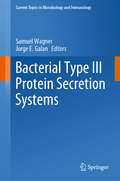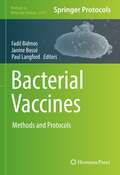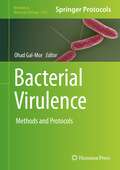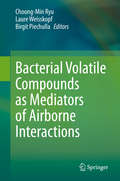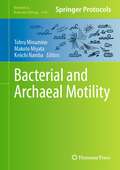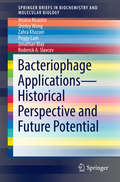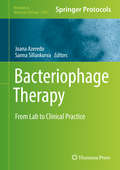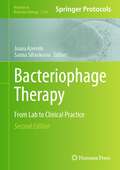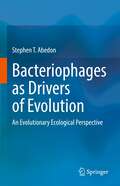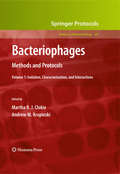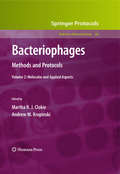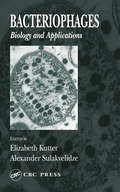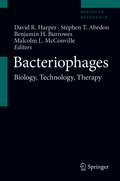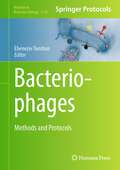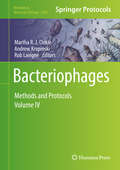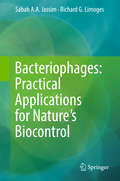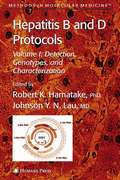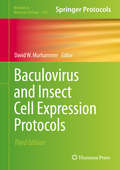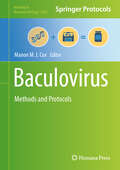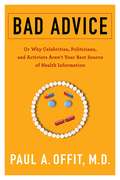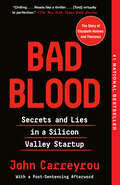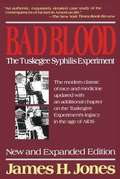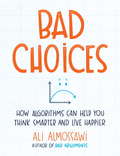- Table View
- List View
Bacterial Type III Protein Secretion Systems (Current Topics in Microbiology and Immunology #427)
by Samuel Wagner Jorge E. GalanOne of the most exciting developments in the field of bacterial pathogenesis in recent years is the discovery that many pathogens utilize complex nanomachines to deliver bacterially encoded effector proteins into eukaryotic and prokaryotic target cells to modulate a variety of cellular functions for the pathogen’s benefit. These protein-delivery machines include the type III secretion system (T3SS), which is widespread in nature and encoded not only by bacteria pathogenic to vertebrates or plants, but also by bacteria that are symbiotic to plants or insects. Because they are essential virulence factors for many important human pathogens, these systems are emerging as a prime target for the development of new-generation, anti-infective drugs. This book reviews our current understanding of these intriguing injection machines as well as of the closely related T3SS that serves in flagella assembly. Individual chapters focus on regulation, assembly, structure, and function of the type III secretion machine and on the evolution of the secreted effector proteins. Given its scope, this book will appeal to a broad readership, including researchers and teachers in the fields of infectious diseases, host pathogen interactions, plant and animal pathogenesis, and symbiosis.
Bacterial Vaccines: Methods and Protocols (Methods in Molecular Biology #2414)
by Paul Langford Fadil Bidmos Janine BosséThe importance of vaccines to combat bacterial diseases cannot be overstated. Methods used in the development and testing of these vaccines are evolving rapidly as a direct consequence of the availability of advanced technologies. This volume will cover methods developed in the last decade, the usage of which are enabling the development of cheaper, cost-effective and structurally stable vaccines for global use. Chapters cover in silico analytical methods such as reverse vaccinology and machine learning; low-energy electron irradiation for the generation of inactivated bacterial vaccines; methods for assessment of OMV/GMMA quality and stability; and controlled human infection models. Written in the highly successful Methods in Molecular Biology series format, chapters include introductions to their respective topics, lists of the necessary materials and reagents, step-by-step, readily reproducible laboratory protocols, and tips on troubleshooting and avoiding known pitfalls. Cutting-edge and comprehensive, Bacterial Vaccines: Methods and Protocols is a valuable resource for novice and expert researchers interested in learning more about this important and constantly evolving field.
Bacterial Virulence: Methods and Protocols (Methods in Molecular Biology #2427)
by Ohad Gal-MorThis detailed volume explores the field of bacterial virulence and the effort to understand how microbial interaction with a host results in the pathology of a specific disease. This collection of selected protocols includes advanced molecular biology and bioinformatics methods, cell culture and organoid models of infection, as well as in vivo infection models that are useful to study the interaction of pathogens with plants, insects, avian, and mammalian hosts. Written for the highly successful Methods in Molecular Biology series, chapters include introductions to their respective topics, lists of the necessary materials and reagents, step-by-step, readily reproducible protocols, and tips on troubleshooting and avoiding known pitfalls. Authoritative and beneficial, Bacterial Virulence: Methods and Protocols serves as an ideal guide for researchers seeking to promote and further develop the exciting and continuously evolving field of bacterial virulence.Chapter 19 is available open access under a Creative Commons Attribution 4.0 International License via link.springer.com.
Bacterial Volatile Compounds as Mediators of Airborne Interactions
by Birgit Piechulla Choong-Min Ryu Laure WeisskopfThis book covers the fundamentals of bacterial volatile-mediated communication with other organisms, starting with the biosyntheses of volatile organic compounds (VOC), interactions with plants and animals, interactions with microbes, tools for data analysis, and their applications. With this foundation in place, the book subsequently focuses on understanding the effect of bacterial volatiles on plant growth promotion, discusses plant immunity, and lastly shares insights into future research directions. The book is divided into fourteen-in-depth chapters, each of which is designed to enrich readers’ understanding of bacterial volatile compounds’ functions and various applications.The pivotal roles of bacterial volatile compounds make this book essential reading for scientists and students of all biological disciplines seeking to fully understand microorganism responses and environmental adaptations. In addition to its value as a fundamental book for graduate students, it offers a clearly structured reference guide for all individuals working in microbiology.
Bacterial and Archaeal Motility (Methods in Molecular Biology #2646)
by Tohru Minamino Keiichi Namba Makoto MiyataThis detailed volume presents cutting-edge research protocols to study the structure and dynamics of bacterial and archaeal motility systems using bacterial genetics, molecular biology, biochemistry, biophysics, structural biology, cell biology, microscopy imaging, and molecular dynamics simulation. Beginning with a section on bacterial flagellar protein export and assembly, the book continues with chapters covering flagella-driven motility of bacteria, archaella-driven motility of archaea, type IV-driven twitching motility of bacteria, as well as adhesion-based gliding motility of bacteria and other unique motility systems. Written for the highly successful Methods in Molecular Biology series, chapters include introductions to their respective topics, lists of the necessary materials and reagents, step-by-step and readily reproducible laboratory protocols, and tips on troubleshooting and avoiding known pitfalls. Authoritative and thorough, Bacterial and Archaeal Motility is the ideal reference for researchers working in this vital area of microbiology.
Bacteriocins
by Qing GuThis book intends to report the new results of the study of bacteriocins, from basic research to application fields. It mainly introduces the biological characteristics of bacteriocins, the relationship between their structure and function, the antibacterial mode of action, and their application as antibacterial agents in food industry, medical care, and other areas, especially their application potential in human health. This book can be used as a reference book for researchers, undergraduates, and graduated students in the professional fields of food science and engineering, bioengineering, medicine, and agriculture.
Bacteriophage Applications - Historical Perspective and Future Potential (SpringerBriefs in Biochemistry and Molecular Biology)
by Jessica Nicastro Shirley Wong Zahra Khazaei Peggy Lam Jonathan Blay Roderick A. SlavcevThis book explores key applications of phage biotechnology and reviews recent advances in phage display technologies. The applications covered were selected on the basis of their significance and representativeness in the field. The small size and enormous diversity of bacteriophages make them ideal candidates for numerous applications across many industries. Since the discovery of phages and the advent of phage display systems, considerable attention has been focused on the development of novel therapeutic and industrial applications. Recent studies combine the genomic flexibility of phages with phage display systems in order to generate modified phages for targeted delivery.
Bacteriophage Therapy: From Lab to Clinical Practice (Methods in Molecular Biology #1693)
by Joana Azeredo Sanna SillankorvaThis volume details the experimental approaches suitable for isolating and characterizing bacteriophages to formulating bacteriophage medicinal products and clinical application. Chapters guide readers through regulatory compliance and safety aspects of bacteriophage therapy. Written in the highly successful Methods in Molecular Biology series format, chapters include introductions to their respective topics, lists of the necessary materials and reagents, step-by-step, readily reproducible laboratory protocols, and tips on troubleshooting and avoiding known pitfalls. Authoritative and cutting-edge, Bacteriophage Therapy: From Lab to Clinical Practiceaims to ensure successful results in the further study of this vital field.
Bacteriophage Therapy: From Lab to Clinical Practice (Methods in Molecular Biology #2734)
by Joana Azeredo Sanna SillankorvaThis highly anticipated second edition details cutting-edge experimental approaches for bacteriophage research. This comprehensive volume details new and updated experimental approaches for isolating, formulating, and engineering bacteriophage medicinal products. Authored by leading experts and written in the highly successful Methods in Molecular Biology series format, each chapter includes introductions to their respective topics, lists of the necessary materials and reagents, step-by-step reproducible laboratory protocols, and valuable tips for troubleshooting and avoiding known pitfalls. Whether you are a seasoned scientist or a newcomer, Bacteriophage Therapy: From Lab to Clinical Practice, Second Edition provides essential tools and knowledge to advance bacteriophage research and its translation into innovative medicinal products and clinical therapies.
Bacteriophages as Drivers of Evolution: An Evolutionary Ecological Perspective
by Stephen T. AbedonThis monograph emphasizes the many facets of bacterial evolution as impacted by bacterial interactions with phages, as well as, to a lesser degree, the evolutionary impact of phages on other organisms, including other phages. The book starts with a general overview of bacteriophages. Topics discussed in detail include but are not limited to mutagenesis, migration, natural selection and genetic drift as the drivers of evolution as well as an extensive discussion from the author’s unique perspective on phage ecology.
Bacteriophages, Volume 1: Methods and Protocols, Volume 1: Isolation, Characterization, and Interactions (Methods in Molecular Biology #501)
by Andrew Kropinski Martha R. ClokieRanging from the evolution of pathogenicity to oceanic carbon cycling, the many and varied roles that bacteriophages play in microbial ecology and evolution have inspired increased interest within the scientific community. Bacteriophages: Methods and Protocols pulls together the vast body of knowledge and expertise from top international bacteriophage researchers to provide both classical and state-of-the-art molecular techniques. With its well-organized modular design, Volume 1: Isolation, Characterization, and Interactions examines a multitude of topics, including the isolation of phages, morphological and molecular characterization, and interaction with bacteria. Written in the highly successful Methods in Molecular BiologyTM series format, chapters consist of brief introductions to the subject, lists of the necessary materials and reagents, readily reproducible laboratory protocols, and a Notes section which details tips on troubleshooting and avoiding known pitfalls.<P><P> Thorough and cutting-edge, Bacteriophages: Methods and Protocols is a valuable reference for experienced bacteriophage researchers as well as an easily accessible introduction for newcomers to the subject.
Bacteriophages, Volume 2: Methods and Protocols, Volume 2: Molecular and Applied Aspects (Methods in Molecular Biology #502)
by Andrew Kropinski Martha R. ClokieRanging from the evolution of pathogenicity to oceanic carbon cycling, the many and varied roles that bacteriophages play in microbial ecology and evolution have inspired increased interest within the scientific community. Bacteriophages: Methods and Protocols pulls together the vast body of knowledge and expertise from top international bacteriophage researchers to provide both classical and state-of-the-art molecular techniques. With its well-organized modular design, Volume 2: Molecular and Applied Aspects examines a multitude of topics, including the bacteriophage genomics, metagenomics, transcriptomics, and proteomics, along with applied bacteriophage biology. Written in the highly successful Methods in Molecular Biology™ series format, chapters consist of brief introductions to the subject, lists of the necessary materials and reagents, readily reproducible laboratory protocols, and a Notes section which details tips on troubleshooting and avoiding known pitfalls.<P><P> Thorough and cutting-edge, Bacteriophages: Methods and Protocols is a valuable reference for experienced bacteriophage researchers as well as an easily accessible introduction for newcomers to the subject.
Bacteriophages: Biology and Applications
by Elizabeth Kutter Alexander SulakvelidzeIn response to the emergence of pathogenic bacteria that cannot be treated with current antibiotics, many researchers are revisiting the use of bacteriophages, or phages, to fight multidrug-resistant bacteria. Bacteriophages: Biology and Applications provides unparalleled, comprehensive information on bacteriophages and their applications, such as
Bacteriophages: Biology, Technology, Therapy
by David R. Harper Stephen T. Abedon Benjamin H. Burrowes Malcolm L. McConvilleThis first major reference work dedicated to the mannifold industrial and medical applications of bacteriophages provides both theoretical and practical insights into the emerging field of bacteriophage biotechnology. The book introduces to bacteriophage biology, ecology and history and reviews the latest technologies and tools in bacteriophage detection, strain optimization and nanotechnology. Usage of bacteriophages in food safety, agriculture, and different therapeutic areas is discussed in detail. This book serves as essential guide for researchers in applied microbiology, biotechnology and medicine coming from both academia and industry.
Bacteriophages: Methods and Protocols (Methods in Molecular Biology #2738)
by Ebenezer TumbanThis volume provides detailed protocols for the isolation, enumeration, characterization of diverse bacteriophages, including both small to jumbo bacteriophages, from soil, fecal, municipal wastewater, and from food niche samples. Chapters highlight the diversity of bacteriophages in different environments, quantifications using culture, molecular techniques, protocols for isolate, interaction of bacteriophage proteins with host cells, and how to use bacteriophages to transfer foreign genetic elements to bacterial strains. In addition to the above, chapters feature the application of bacteriophages/bacteriophage-derived products. Written in the highly successful Methods in Molecular Biology series format, chapters include introductions to their respective topics, lists of necessary materials and reagents, step-by-step, readily reproducible laboratory protocols, and tips (in the Notes section) on troubleshooting and avoiding known pitfalls. Authoritative and cutting-edge, Bacteriophages: Methods and Protocols aims to ensure successful results in further study of this vital field.
Bacteriophages: Methods and Protocols, Volume 3 (Methods in Molecular Biology #1681)
by Martha R.J. Clokie Andrew M. Kropinski Rob LavigneRanging from the evolution of pathogenicity to oceanic carbon cycling, the many and varied roles that bacteriophages play in microbial ecology and evolution have inspired increased interest within the scientific community. Bacteriophages: Methods and Protocols pulls together the vast body of knowledge and expertise from top international bacteriophage researchers to provide both classical and state-of-the-art molecular techniques. With its well-organized modular design, Volume 2: Molecular and Applied Aspects examines a multitude of topics, including the bacteriophage genomics, metagenomics, transcriptomics, and proteomics, along with applied bacteriophage biology. Written in the highly successful Methods in Molecular Biology(tm) series format, chapters consist of brief introductions to the subject, lists of the necessary materials and reagents, readily reproducible laboratory protocols, and a Notes section which details tips on troubleshooting and avoiding known pitfalls. Thorough and cutting-edge, Bacteriophages: Methods and Protocols is a valuable reference for experienced bacteriophage researchers as well as an easily accessible introduction for newcomers to the subject.
Bacteriophages: Methods and Protocols, Volume IV (Methods in Molecular Biology #1898)
by Andrew Kropinski Martha R. Clokie Rob LavigneThis book expands on the previous volumes with new chapters focusing on functional characterization of phage and their proteins, and on the development of phage therapy by outlining novel models. The chapters in this book cover molecular topics such as PhageFISH for monitoring phage infections at single cell level; the analysis of phage-host protein-protein interactions using Strep-tag® II purifications; and also application driven chapters including 'duckweed (Lemna minor) and alfalfa (Medicago sativa) as bacterial infection model systems’. Written in the highly successful Methods in Molecular Biology series format, chapters include introductions to their respective topics, lists of the necessary materials and reagents, step-by-step, readily reproducible laboratory protocols, and tips on troubleshooting and avoiding known pitfalls.Innovative and thorough, Bacteriophages: Methods and Protocols, Volume IV is a valuable resource for both established and novice phage scientists.
Bacteriophages: Practical Applications for Nature's Biocontrol
by Sabah A.A. Jassim Richard G. LimogesBacteriophages: Practical Applications for Nature's Biocontrol' presents the latest information on uses in healthcare settings as well as animal husbandry, management and care of farm animals by using enhanced phages to replace antibiotics for growth promotion in animal feed or to prevent, control and treat disease in animals. The book will provide an overview of the function of phages and what researchers need to know, from phage hunting to laboratory design, management, production and application using different tools and methods. These key aspects will be discussed through a series of dedicated chapters, with topics covering auditing, validation, data analysis, microbial identification, culture media, and contamination control, etc.
Baculovirus Expression Protocols (Methods in Molecular Biology #39)
by Christopher D. RichardsonBaculovirus Expression Protocols offers both industrial and university-based researchers a comprehensive comilation of the latest baculovirus techniques along with step-by-step instructions and time-saving techniques. The contributors-leading authorities in the field-present the assorted expression plasmids currently in use, guide the reader through the process of generating and selecting recombinant virus, and describe specific examples of recombinant protein production and purification. The emphasis is on alternative and simpler screening techniques for the selection of recombinant baculovirus. The book also surveys the various insect cell lines currently compatible with the baculovirus system. Highlights include production of recombinant virus using linearized DNA and vectors that contain a b-galactosidase indicator and a complete list of expression vectors currently available. Detailed descriptions for the scale-up of protein production using spinner flasks, bioreactors, and insect larvae are also included. Baculovirus Expression Protocols offers both industrial and university-based researchers an outstanding collection of reproducible, step-by-step laboratory protocols. It will immediately become indispensable for anyone working with baculoviruses and their application in the expression of recombinant proteins in insect cells.
Baculovirus and Insect Cell Expression Protocols (Methods in Molecular Biology #1350)
by David W. MurhammerBaculovirus Expression Protocols, Second Edition, provides the detailed steps required to perform the techniques involved with the use of baculoviruses and insect cell culture and discusses problems that may be encountered. This newly-revised and updated edition provides a cutting edge step-by-step guide for biochemists, molecular biologists, biochemical engineers and others using the BEVS and/or insect cells for producing recombinant proteins. Furthermore, Baculovirus Expression Protocols, Second Edition, provides assistance to scientists and engineers interested in developing and producing baculovirus insecticides. Authors list all available insect cell lines and provide methods for isolating new cell lines. The procedures involved in producing products, both at laboratory scale and large scale, are discussed, as well as the production in insect larvae. It is hoped that this volume will not only aid the user in successfully completing the tasks described herein, but will also stimulate the development of improved techniques and new applications of baculoviruses and insect cell culture. Timely and thorough, this volume will become an essential reference for anyone using baculoviruses and insect cell culture.
Baculovirus: Methods and Protocols (Methods in Molecular Biology #2829)
by Manon M. J. CoxThis detailed volume provides up-to-date guidance on techniques used to work with baculoviruses and insect cells. The book provides basic methods to create recombinant baculoviruses, to improve productivity, to produce a variety of products, to purify products, to quantify baculovirus stocks or to quantify product produced, and it concludes with alternative uses of either baculovirus or insect cells as tools. Written for the highly successful Methods in Molecular Biology series, chapters include introductions to their respective topics, lists of the necessary materials and reagents, step-by-step and readily reproducible laboratory protocols, and tips on troubleshooting and avoiding known pitfalls. Authoritative and comprehensive, Baculovirus: Methods and Protocols serves as an ideal guide for researchers looking to overcome some of the limitations associated with the early baculoviral vectors and cell lines.
Bad Advice: Or Why Celebrities, Politicians, and Activists Aren't Your Best Source of Health Information
by Paul OffitScience doesn’t speak for itself. Neck-deep in work that can be messy and confounding, and naïve in the ways of public communication, scientists are often unable to package their insights into the neat narratives that the public requires. Enter the celebrities, the advocates, the lobbyists, and the funders behind them, who take advantage of scientists’ reluctance to provide easy answers, flooding the media with misleading or incorrect claims about health risks. Amid this onslaught of spurious information, Americans are more confused than ever about what’s good for them and what isn’t.In Bad Advice, Paul A. Offit shares hard-earned wisdom on the do’s and don’ts of battling misinformation. For the past twenty years, Offit has been on the front lines in the fight for sound science and public heath. Stepping into the media spotlight as few scientists have done—such as being one of the first to speak out against conspiracy theories linking vaccines to autism—he found himself in the crosshairs of powerful groups intent on promoting pseudoscience. Bad Advice discusses science and its adversaries: not just the manias stoked by slick charlatans and their miracle cures but also corrosive, dangerous ideologies such as Holocaust and climate-change denial. Written with wit and passion, Offit’s often humorous guide to taking on quack experts and self-appointed activists is a must-read for any American disturbed by the recent uptick in politicized attacks on science.
Bad Blood: Secrets and Lies in a Silicon Valley Startup
by John Carreyrou<P>The full inside story of the breathtaking rise and shocking collapse of Theranos, the multibillion-dollar biotech startup, by the prize-winning journalist who first broke the story and pursued it to the end, despite pressure from its charismatic CEO and threats by her lawyers. <P>In 2014, Theranos founder and CEO Elizabeth Holmes was widely seen as the female Steve Jobs: a brilliant Stanford dropout whose startup "unicorn" promised to revolutionize the medical industry with a machine that would make blood testing significantly faster and easier. <P>Backed by investors such as Larry Ellison and Tim Draper, Theranos sold shares in a fundraising round that valued the company at more than $9 billion, putting Holmes's worth at an estimated $4.7 billion. <P>There was just one problem: The technology didn't work. <P>A riveting story of the biggest corporate fraud since Enron, a tale of ambition and hubris set amid the bold promises of Silicon Valley. <P><b>A New York Times Bestseller</b>
Bad Blood: The Tuskegee Syphilis Experiment New and Expanded Edition
by James Jones1932 - 1972 - Alabama. Describes a study in which poor African Americans were denied appropriate medical treatment.
Bad Choices: How Algorithms Can Help You Think Smarter and Live Happier
by Ali AlmossawiThe wildly popular author of Bad Arguments returns with a funny, smart introduction to algorithms—those perennially misunderstood, increasingly important problem-solving rules that can save you time and lead to better choices, every day. Why is Facebook so good at predicting what you like? How do you discover new music? What's the best way to sort your laundry?Readers around the world have embraced Ali Almossawi's whimsical illustrations—drawn by his collaborator Alejandro Giraldo—and his funny, clarifying explanations of complex subjects. In fewer than 200 pages, Almossawi demystifies a new topic of increasing relevance to our lives: algorithms. Bad Choices is a book for anyone who's looked at a given task and wondered if there was a better, faster way to get the task done. What's the best way to organize a grocery list? What's the secret to being more productive at work? How can we better express ourselves in 140-characters? Presenting us with alternative methods for tackling twelve different scenarios, Almossawi guides us to better choices that borrow from same systems that underline a computer word processor, a Google search engine, or a Facebook ad. Once you recognize what makes a method faster and more efficient, you'll become a more nimble, creative problem-solver, ready to face new challenges. Bad Choices will open the world of algorithms to all readers making this a perennial go-to for fans of quirky, accessible science books.From the Hardcover edition.
